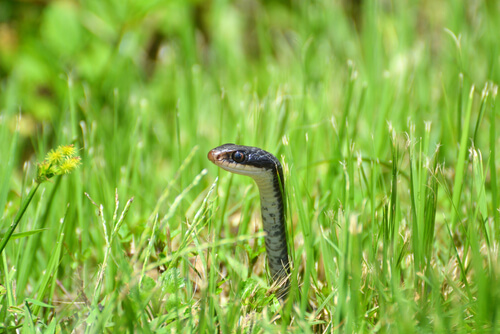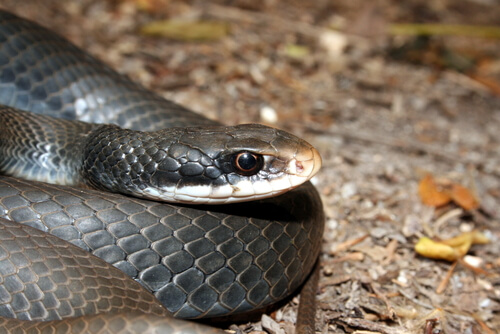
| Kingdom | Animalia |
| Phylum | Chordata |
| Class | Reptilia |
| Order | Squamata |
| Family | Colubridae |
| Genus | Coluber |
| Species | Coluber constrictor |
| Niche | Non-venomous predator |
| Length | 20-60 in (51-160 cm) |
| Weight | 1.25 lb (560 g) |
| Lifespan | 10 years |
| Social Structure | Solitary |
| Conservation Status | Least Concern (IUCN) |
| Preferred Habitat | Wooded areas and thickets |
| Average Clutch Size | 20 |
| Main Prey Species | Smaller snakes, rodents, amphibians, insects, lizards |
| Predators | Birds of prey, larger snakes, rodents, amphibians, lizards |
The Basics
Black racer snake (Coluber constrictor) refers to several subspecies of large, black, non-venomous snakes common in the southern United States. Black racers have long, smooth, slender bodies with solid black or dark grey scales. They have large eyes and typically some white coloration on the underside of their heads. The rest of their underside is dark grey or black, but typically lighter than their dorsal side. Racers typically grow to between 20-60 inches (51-160 cm) long, making it a relatively large snake.

Black racer snakes can be found from throughout the American southeast, from southern Maine to the Florida keys. Within this range, there are various subspecies. Black racers are habitat generalists but prefer to spend their time around the edges of forests, fields, or wetlands hunting and hiding in the grass and other vegetation.
Predator and Prey
Black racers will hunt various small animals such as insects, other snakes and lizards, and even frogs. They will also eat various small mammals such as moles and other rodents. Black racer snakes face the threat of being preyed upon by various mammals and other snakes and reptiles larger than them. Also, birds of prey such as hawks are known to attack them from the sky. Their eggs are also at risk from various animals like raccoons and foxes who will invade their nests when given the opportunity.
However, like most species, humans are perhaps their greatest threats. Many black racers are killed by vehicles on roadways while others are killed out of fear or mistaking them for a dangerous snake, such as the Water Moccasin snake that also occurs in its range. Nonetheless, their populations remain fairly strong and the species is currently listed as “Least Concern” by the IUCN.

Reproduction
Each spring, Black racer snake females lay about 20 eggs at a time. Later that summer or fall, the small, snakes will emerge from their shells. They are about 6 inches (15 cm) long at the time of birth. Like most reptiles, adult snakes do not provide any care for their young. Left to fend for themselves, the baby snakes will rely heavily on camouflage in their early days. They are a less conspicuous color than the bold black adult snakes. They are often spotted with tan, black, and white coloration. By the time the young snakes are about 12 inches (30 cm) long, the black spots merge and form the solid black coloration seen in adults. This camouflage is not perfect, however. Indeed, only about 40 percent of hatchlings survive their first year.
Fun Facts about Black Racer Snake!
Black racer snakes are common throughout their range, as are several other types of black snakes, some venomous. This creates confusion, which isn’t helped by the fact that C. constrictor is not even a classic constricting snake as its binomial name would suggest.
A Bit Like the Others
It is easy to mistake black racer snakes for several other black snakes that occur within its range. The black rat snake, for example, as well as black king snakes both occur alongside the black racer at times. The black-phase eastern hognose snake also overlaps with the black racer.

As a general rule, however, black racers are more slender and uniformly black than other black snakes that occur in the same regions. If close enough, you may also notice that it lacks the upturned nose of a hognose snake or the ‘keeled’ scales of hognose and rat snakes. If observing the snake while approaching from a distance, their behavior is another way to distinguish between black snakes. While king, rat, and hognose snakes will usually freeze when approached, racers will often attempt to flee quickly. On occasion, they will also stand their ground and prepare to strike, especially if they don’t have an escape route.
Not a Constrictor
Despite their scientific name, Coluber constrictor, black racer snakes are not a constricting species such as boa constrictors. Although they have many common physical characteristics, they do not subdue their prey by coiling around them to suffocate them. Instead, they will typically bite them and then crush and suffocate their prey against the ground before consuming it, sometimes live. They will often attack near water, using it to their advantage in subduing their prey by drowning it as well.
Stay Away
Like a rattlesnake, the black racer snake will shake its tail in the grass when it is threatened as if to warn the potential threat to stay away. Also, they will often bite if cornered. However, unlike rattlesnakes, they are not poisonous and will likely flee instead of strike if approached by a large animal. They will often take on a strange ‘kinked’ position when resting, apparently as a form of camouflage. While in this position, the black racer snake tends to appear more like a branch or stick at a glance than a resting snake.
Day Tripper
Black racers are active during the daytime. Many snakes will hide under rocks or burrow during the day to avoid extreme heat and predators. To compensate for this risky behavior black racers are very fast, hence their name ‘racer’. This speed allows them a better chance to escape any predators that may spot them out and about during the day. At night and during cool weather they will seek shade and remain inactive.
